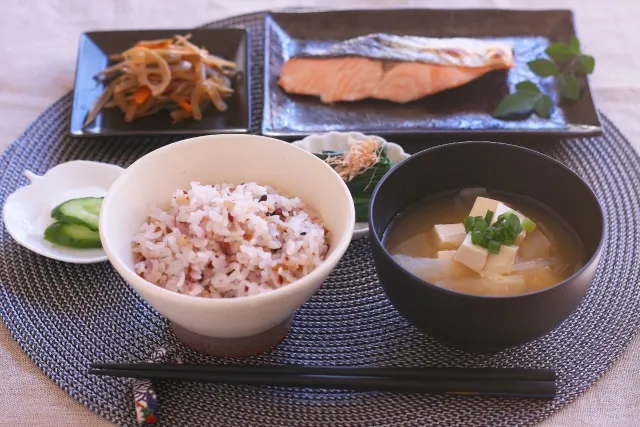
Today’s topic of learning English and Japanese is seasoning. 今日のトピックは、調味料です。
和食を作る上で欠かせない調味料が、醤油や味噌などです。今回は、これら和食に使う調味料の作り方を紹介します。
醤油:醤油の原料は、大豆、小麦、塩、麹です。大豆を蒸して、小麦を炒った後に、麹により半年ほど発酵、熟成させます。液体を分離して、熱を加えて完成です。
味噌:味噌の原料は、大豆、塩、麹です。大豆を煮た後、潰します。塩と麹を混ぜ、樽に詰めて1年発酵させて出来上がりです。
みりん:みりんの原料は、お米と麹です。米を蒸した後、麹をかけ2年ほど発酵させます。液体を分離して、熱を加えて完成です。
出汁:お湯に、昆布や鰹節、煮干しなどを加えて、素材の味を引き出したものを出汁と言います。
出汁以外の上記3つの調味料の共通点は、麹と発酵です。麹は、食品に用いることができるコウジカビのことで、菌を使って大豆やお米を発酵させます。発酵は、食べ物の栄養価や保存性を高める働きがあります。
Seasoning required for Japanese cuisine (called Washoku) is soy sauce, miso, and so on. In this post, I will introduce how to make these seasonings for Washoku.
Son sauce: Soy sauce is made from soybeans, wheat, salt, and malted rice. After steaming soybeans and roasting wheat, they are fermented and matured with salt and malted rice for about six months. The liquid is separated from that and heated. Done!
Miso: Miso is made from soybeans, salt, and malted rice. After boiling soybeans, it’s crushed. The crushed soybean is mixed with salt and malted rice, they are fermented in a barrel for a year, and it’s finished.
Mirin (sweet sake): Mirin is made from rice and malted rice. After steaming rice, it’s fermented with malted rice for about 2 years. The liquid is separated from that and heated. Done!
Dashi (broth): Dashi is that kelp, bonito flakes, or dried sardines are boiled in hot water and brought out the flavors of the ingredients.
Common things of the above three seasonings except for Dashi are malted rice and fermentation. Malted rice is Aspergillus that can be used for foods, it makes soybeans and rice ferment. Fermentation has roles, which increase nutrients of foods and extend the retention period.
語彙(goi) / Vocabulary
〜からできています(~ kara deki te i masu):be made from ~
みりん(mirin):sweet (rice) sake
鰹節(katuobusi ):bonito flakes
〜を引き出す(~ wo hi ki da su):bring out ~
ひらがな(hiragana)
わしょく を つく る うえ で か かせない ちょうみりょう が 、 しょうゆ や みそ など です 。 こんかい は 、 これら わしょく に つか う ちょうみりょう の つく り かた を しょうかい し ます 。
しょうゆ : しょうゆ の げんりょう は 、 だいず 、 こむぎ 、 しお 、 こうじ です 。 だいず を む し て 、 こむぎ を い っ た あと に 、 こうじ に より はんとし ほど はっこう 、 じゅくせい さ せ ます 。 えきたい を ぶんり し て 、 ねつ を くわ え て かんせい です 。
みそ : みそ の げんりょう は 、 だいず 、 しお 、 こうじ です 。 だいず を に た あと 、 つぶ し ます 。 しお と こうじ を ま ぜ 、 たる に つ め て 1 ねん はっこう さ せ て できあ がり です 。
みりん : みりん の げんりょう は 、 お こめ と こうじ です 。 べい を む し た あと 、 こうじ を かけ 2 ねん ほど はっこう さ せ ます 。 えきたい を ぶんり し て 、 ねつ を くわ え て かんせい です 。
だし : お ゆ に 、 こんぶ や かつおぶし 、 にぼ し など を くわ え て 、 そざい の あじ を ひ き だ し た もの を だし と い い ます 。
だし いがい の じょうき 3 つ の ちょうみりょう の きょうつうてん は 、 こうじ と はっこう です 。 こうじ は 、 しょくひん に もち いる こと が できる こうじ かび の こと で 、 きん を つか っ て だいず や お こめ を はっこう さ せ ます 。 はっこう は 、 た べ もの の えいようか や ほぞんせい を たか める はたら き が あり ます 。
ローマ字(romaji) / Roman character
wasyoku wo tuku ru ue de ka kasenai tyoumiryou ga 、 syouyu ya miso nado desu 。 konkai ha 、 korera wasyoku ni tuka u tyoumiryou no tuku ri kata wo syoukai si masu 。
syouyu : syouyu no genryou ha 、 daizu 、 komugi 、 sio 、 kouzi desu 。 daizu wo mu si te 、 komugi wo i xtu ta ato ni 、 kouzi ni yori hantosi hodo hakkou 、 zyukusei sa se masu 。 ekitai wo bunri si te 、 netu wo kuwa e te kansei desu 。
miso : miso no genryou ha 、 daizu 、 sio 、 kouzi desu 。 daizu wo ni ta ato 、 tubu si masu 。 sio to kouzi wo ma ze 、 taru ni tu me te 1 nen hakkou sa se te dekia gari desu 。
mirin : mirin no genryou ha 、 o kome to kouzi desu 。 bei wo mu si ta ato 、 kouzi wo kake 2 nen hodo hakkou sa se masu 。 ekitai wo bunri si te 、 netu wo kuwa e te kansei desu 。
dasi : o yu ni 、 konbu ya katuobusi 、 nibo si nado wo kuwa e te 、 sozai no azi wo hi ki da si ta mono wo dasi to i i masu 。
dasi igai no zyouki 3 tu no tyoumiryou no kyoutuuten ha 、 kouzi to hakkou desu 。 kouzi ha 、 syokuhin ni moti iru koto ga dekiru kouzi kabi no koto de 、 kin wo tuka xtu te daizu ya o kome wo hakkou sa se masu 。 hakkou ha 、 ta be mono no eiyouka ya hozonsei wo taka meru hatara ki ga ari masu 。
日本語、英語で、文章がおかしいところはビシバシと指摘してくださいね。一緒に、楽しく英語や日本語を学んでいきましょう。
Please let me know, if you find any mistakes in my sentences in Japanese or English. Let’s study English and Japanese with lots of fun together.